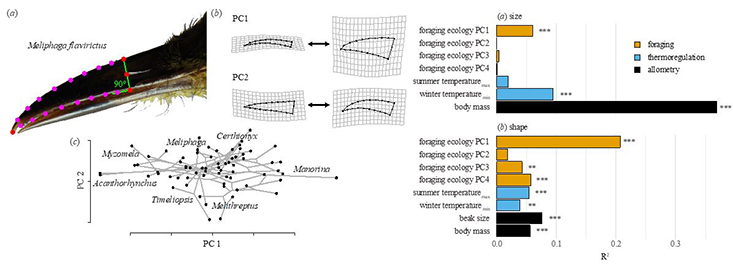Evolution of complex traits in birds
Birds’ behavior in the wild integrates input from many features of their anatomy. Each of these morphological features is bound by function to many behaviors, and each of these can involve numerous environmental and ecological interactions. We aim to disentangle these complex relationships to understand the evolution of the diversity of avian forms, colors, and sounds. To accomplish this, we use modern measurements of avian morphology (e.g., micro-CT, geometric morphometrics) and relate them to ecology and evolutionary history using phylogenetic comparative methods. Most of this work has focused on the Australasian honeyeaters and allies (Meliphagoidea) as a model clade. However, the diverse collection at the Hamburg Museum of Nature opens up many new opportunities to study the evolution of avian diversity, especially for feather coloration, beak morphology, and singing behavior.
Example:

Publications:
- Friedman, N. R., V. Remes. Plumage color evolves as distinct dorsal and ventral modules in Australasian honeyeaters. https://doi.org/10.1101/2022.08.23.504757
- Friedman, N. R., E. T. Miller, J. R. Ball, H. Kasuga, V. Remes*, E. P. Economo*. 2019. Evolution of a multifunctional trait: shared effects of foraging ecology and thermoregulation on beak morphology, with consequences for song evolution. Proceedings of the Royal Society B 286, 20192474.
- Friedman, N. R., V. Remes. 2017. Ecogeographic gradients in plumage coloration among Australasian songbird lineages. Global Ecology and Biogeography 26, 261-274.

